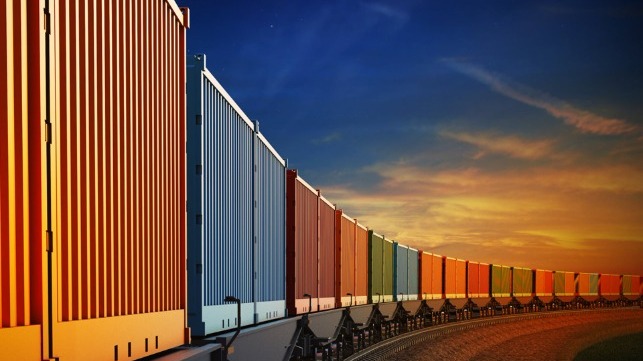Samskip Shines on the Silk Road

[By: Samskip]
Faster, greener container rail services between China and Europe are now also more cost-efficient than the all-water alternative. Rachelle Slingerland, Samskip Logistics Business Development Manager, says shippers are benefiting from new levels of supply chain visibility as a result
Urgent container capacity shortages and intense sea freight rate inflation are giving an extra push to rail cargo service links between China and Europe, as a fresh crop of long distance shippers find the speed, reliability and inland penetration available from multimodal options compelling.
Samskip Logistics Business Development Manager Rachelle Slingerland suggests a recent traffic surge of 10-15% in loads moving overland between China and Europe highlights the growing appeal of established ‘silk road’ rail services over their deep sea counterparts.
In the north, services crossing Siberia connect Beijing and Harbin to Hamburg, while Duisburg is the European endpoint for southerly services through Iran and Turkey to/from Guangzhou - home to the Samskip Duisburg Rail Terminal. Connections into either rail route include Changsha, Chengdu Shanghai, Heifei and Wuhan and Xi-an.
With transit times between 16-18 days comparing to around 35 days for Shanghai-Rotterdam 40ft high-cube container moves by sea, speed is certainly a key advantage for rail, with the superiority gap widening as distances lengthen between Chinese seaports and locations inland. know, I know
Smoother supply chain
“These routes are attractive for higher value products, including electric bicycles, laptops, smartphones and other electrical goods, and clothing westbound, with eastbound moves for cars, alcohol and furniture: temperature-controlled loads move more efficiently both ways,” says Slingerland. “Faster service means suppliers can react more quickly to changing market demands and plan for holding less stock in the supply chain.”
Whether booked by shippers or forwarders, Slingerland says Samskip Logistics plugs into distribution and consolidation opportunities available via Samskip’s pan-European shortsea, rail, barge and truck network, for door-door container services or quay-quay moves using third party equipment.
The multimodal option is being strongly boosted by supply chain disruption in traditional sea routes in early 2021, says Slingerland. Coronavirus-related voyage cancellations last year left huge numbers of shipping containers out of position, resulting in a supply chain unable to respond to faster than expected recovery in Chinese exports.
“Just last week, I asked a well-known all-water operator about a shipment to Shanghai,” she says. “I was told I’d have to wait two weeks for the first available container, and another two weeks for the second!” Depending on pre-carriage, it can now be cheaper to ship freight by rail than it is by sea: on a spot basis, with surcharges in China included, Slingerland says Samskip is paying $6 less per tonne for an overland move from Wuhan to North Europe.
Green silk road
“Perhaps it’s no shock that the amount of CO2 generated in moving freight by air between China and North Europe is around 12 times the equivalent rail move,” she observes. “What may be surprising given a container ship’s economies of scale, is that these rail moves generate 25% less CO2 than sea transportation. Last year has shown us that we can do things differently: 2021 is the year for shippers to switch supply chain and focus on shorter transit times combined with lower emissions.”
Also in play are moves by Chinese authorities to invest in improving the rail infrastructure and terminal capacity to support cargoes moving between Europe and Asia. For its part, Slingerland says it may only be a matter of time before local Samskip Logistics offices in China recruit additional staff with a sole focus on managing Silk Road rail freight.
“There is always more that can be done in relationship-building with clients and with partners supporting first/last mile transport. We are also prioritising streamlined cooperation across our organisation and the transparency brought by advanced booking and data management systems. Progress in these areas will help us drive home that faster transit, greater reliability and lower emissions are being delivered along the Silk Road at strongly competitive prices.”
Model for integration
The rail route is a model for how best to integrate dedicated account management, local offices, and the ‘control tower’ approach to customer care that makes shipments fully visible in a supply chain overseen by Samskip Logistics, channelled through Samskip Multimodal services, she says.
In August 2020, Samskip enhanced its rail connection by launching a direct rail service between Amsterdam and Duisburg to support this three-times weekly train service connecting Xi’an and Changsha to Duisburg.
The Amsterdam – Duisburg shuttle is a collaboration involving Nunner Logistics, TMA Terminal Amsterdam, the Port of Amsterdam, and Duisport Group, with DistriRail providing rail haulage.
High frequency rail shuttles link Duisburg to Sweden, Denmark, Poland, Italy and Turkey but companies trading between China and the UK secure particular benefit from the Duisburg-Amsterdam connection into Samskip’s three-times weekly departures to Hull and Tilbury.
“There’s an additional benefit for companies doing business between the UK and China following Brexit, where all customs formalities come under the responsibility of a single organisation,” Slingerland comments.
She believes that coronavirus-driven shipping container shortages are providing a platform for transcontinental rail services to shine in ways that some shippers will find difficult to disregard once logistics balance is restored to deep sea trades.
The products and services herein described in this press release are not endorsed by The Maritime Executive.
